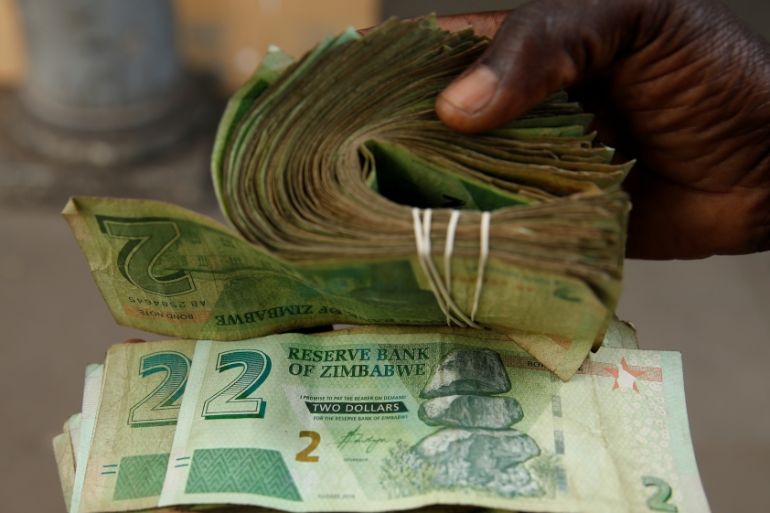‘Where’s the money?’: Zimbabwe’s new banknotes fail to arrive
Banks say there is no communication from central bank on fresh tender intended to ease cash crunch and combat inflation.

New low-denomination banknotes touted by the government of Zimbabwe as the solution to the acute cash shortage crippling the country’s economy failed to arrive on Monday, leaving banks confused and customers frustrated.
The dearth of cash – along with shortages of staple goods exacerbated by a long drought – has sent inflation to its highest since 2008, estimated at 380 percent year on year.
Keep reading
list of 3 itemsIn Zimbabwe, power outages force women to deliver by candlelight
Zimbabwe’s government workers want wages pegged to US dollars
“Where’s the money?”, the government’s mouthpiece, The Herald newspaper, asked in an online report.
The central bank had failed to circulate the new banknotes by the close of business on Monday, it said.
Banking executives told the Reuters news agency that they had received no new bills as expected, or any communication from the Reserve Bank of Zimbabwe (RBZ) about why the notes had not been distributed.
RBZ Governor John Mangudya could not be reached for comment after earlier promising to speak.
“We now think we may get the cash on Tuesday,” an executive at a foreign-owned bank said. “People have been calling all day to inquire whether they can come to make withdrawals.”
The executive, who declined to be named because he is not authorised to speak to the press, said the RBZ’s failure to deliver the notes would add to the mistrust that citizens have towards the central bank.
In 2008, hyperinflation wiped out many Zimbabweans’ pensions and savings and forced the southern African country to dump the Zimbabwe dollar currency.
In June of this year, the government unexpectedly ended a decade of dollarisation by reintroducing the Zimbabwe dollar to give it more flexibility in shaping monetary policy.
Not resolving economic problems
The government hopes the new notes – which will have the same denominations as bond notes currently in circulation – will help end the cash crunch, bring down inflation and speed up the restoration of the long-neglected domestic currency.
The RBZ said it would issue new five-dollar and two-dollar notes as the next stage of that process, similar in design and colour to the bond notes that were introduced in 2016 as a surrogate for United States dollars.
The RBZ has said it plans to inject one billion Zimbabwe dollars in cash into the economy the next six months.
But many locals and market analysts are unconvinced that new notes will do much to alleviate the crisis.
“If only they had introduced higher denomination notes like 50 dollars, that would have made more sense. What do you do with five dollars?” said Rachel Mandeya, a 28-year-old street trader for foreign currencies.
The five-dollar note, the highest new denomination, is worth just 32 US cents and is only enough to buy a bottle of soda.
Tony Hawkins, a professor of business studies at the University of Zimbabwe, said the central bank was trying to deal with “symptoms of a bigger problem”.
That larger issue includes foreign currency shortages, lack of foreign investment, inflation and lack of consumer confidence in policy.
“The new cash will not resolve the economic problems we face,” Hawkins added. “What it means is that we will probably have more cash around to feed the black market for currency.”
Many businesses discount prices by up to 40 percent for customers paying cash and charge more for those using mobile money or bank cards.